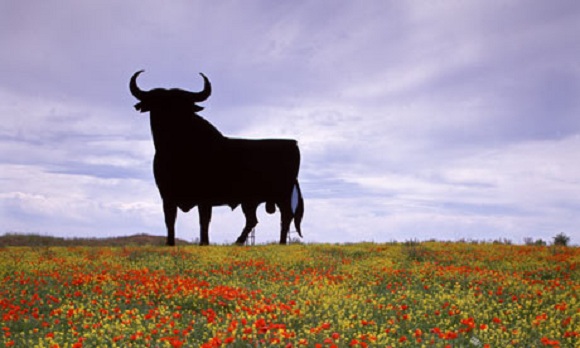The Bull
The Spanish fighting bull, or toro de lidia, is a unique breed of bovine renowned for its exceptional bravery and beauty. The bull’s physical build and natural aggression make this breed appropriate for the bullfight due to its impressive strength as well as its natural instinct to charge (attack). Within the world of bullfighting the bull is seen as the main protagonist of the corrida and the King of the Fiesta, recognised worldwide as a symbol of bravery and resilience as well as the totem of Spanish culture.

Origins
The origin of the fighting bull can be traced back through the different indigenous bovine breeds dating from the 15th Century, though it was not until the middle of the 18th Century that the fighting bull began to become clearly identifiable through the selective breeding process of bull breeders in Spain.
The founding bull breeds were Morucha Castellana, Navarra, Jijona y De la Tierra, Vazquena, Cabrera and Vistahermosa. These breeds not only vary in their physical characteristics, but also in their temperament. In modern times, the predominant bloodline is Vistahermosa, the characteristics of which are considered the most suitable for modern styles of bullfighting. Both toreros and aficionados will have a preferred breed, and this is an area of great discussion within the bullfighting community.

Lifestyle
In a similar way that cattle are selected and reared for the dairy or meat industries, in Spain bulls are reared specifically for the bullfight; they are raised on privately owned bull ranches located all over the country. From the day the bull is born it will roam wild in its own herd, in its natural environment; it enjoys not only the privilege of freedom to roam, but also the benefits of a domestic animal, such as a nutritious diet provided by the breeder, and veterinary care when required.
Having been selected for a bullfight at the required level of maturity (between 4 and 6 years), the bull will be transported by road to the bullring a few days in advance of the event, allowing it to recuperate from the stress of the journey. It is of optimum importance that the bull is treated with care, not only because of its high value (at today's prices approximately 12,000 euros), but also because a bull will only be accepted for a bullfight if it is in perfect physical health. This must be confirmed by a vet upon arrival at the bullring.
A bull will only experience one bullfight in its life. This is seen by the aficionados as the day the bull proves his strength, dignity and bravery, qualities for which the bull is admired by the audience. After the bullfight the meat will be sold for consumption, and is highly appreciated as part of Spain’s rich and varied cuisine. It is worth remembering that bulls which go on to appear in bullfights have a longer (and generally more privileged) life than almost any other cattle bred in the world. A bull bred for meat alone lives for only 18 months or so, whereas the toro de lidia lives for about 5 years on average.
Characteristics

This magnificent animal is admired and revered for inspiring not only fear but also respect. A toro bravo typically weighs between 450 – 650 kilos, and is a highly alert and responsive animal. The bull’s physique is characterised by the distribution of muscle around the neck and shoulders, used to lift and toss with its horns; the length of horns, legs, tail and coloring all vary by breed and bloodline. A bull’s natural behaviour both in the wild and in the bullring is to attack anything it perceives as a threat, a reaction usually triggered by movement and proximity. In the wild the bull will fight with other bulls, in disputes over territories and status, or during the mating season. In the bullring it is the movement of the bullfighter’s capes which attracts the bull to attack instinctively and to charge repeatedly.
The role of the bull in the bullfight
A significant part of the enjoyment of the bullfight is an understanding and appreciation of the bulls themselves, given that no two are the same, and not all bulls are considered as ‘successful’ in the bullfight.
Given that the bullring is a new environment for the bull, and that it has had minimal contact with humans, its behaviour in the ring cannot be predicted. Upon entering the ring, a "manso" or docile bull will flee from confrontation, seeking refuge by the barrier. This kind of behaviour does not reduce the dangerousness of the bull, as a "manso" bull behaves in a more unpredictable manner, making him even more dangerous. On the contrary, a brave bull is one that charges repeatedly and searches for the capes, attacking without tiring or losing interest. This bull possesses positive qualities which can be built on by the matador in order to develop a more complete and advanced performance.
The ideal behaviour of a bull requires not only bravery, but also a number of qualities that facilitate the performance of the matador, and at the same time, make the overall performance more aesthetically attractive. Among these characteristics is the bull’s ‘humility’, which refers to the bull’s positioning of his head as he charges. A bull which lowers its head shows absolute commitment as it attacks, and this allows the matador to perform more fluid and artistic sequences of passes.
Apart from ‘humility’ the bull’s movements and charge must be vigorous and consistent if they are to transmit emotion to the audience.
The success of the matador depends upon the quality of the bull. Given that this is a wild and unpredictable animal, this quality is an unknown factor until the bull enters the ring. For this reason, anything can happen in a bullfight, and the quality of the bull is crucial to the outcome.
